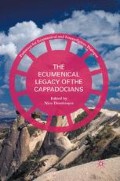Abstract
Even today, creation is a topic where the forces of science and religion appear to be destined to come into conflict. The situation was no different during the age of the Cappadocian Fathers. The great “scientific account” of world generation in antiquity was Plato’s Timaeus, an account firmly rooted in the latest philosophical, scientific, mathematical, and astronomical thought of the day, whose impact could be felt on Aristotelian and Stoic conceptions concerning world generation. The Cappadocians certainly do not provide the most systematic attempt to use Platonism, or Greek philosophy in general, to expound biblical thought: that feat had already been accomplished by the Jewish exegete, Philo of Alexandria, as well as the Christian Origen (although Origen’s Peri Archon is not specifically devoted to explaining the Mosaic account and is much more wide-ranging).2 What the Cappadocians do offer is an example of the use of a philosophical framework to interpret the biblical narrative in a way that is not directed at the intellectual elite but aimed at a more general audience. This corresponds to the general picture of the average Cappadocian in antiquity, who was regarded as more deadly than a snake and “as little likely to speak intelligently as a tortoise might be to fly,”3 although to some extent this perception was due to the limited Hellenization of the region.4 This has also affected how the Cappadocian attempts to engage with Greek philosophy have been perceived, leading to them often facing the accusation that their learning was superficial and essentially derivative, although one must remember that during their own lifetimes, the Cappadocians themselves faced the possibility of being charged with intellectual elitism.
1. I am deeply grateful for fellowships from both the Alexander von Humboldt Foundation in Bonn and the Fritz Thyssen Foundation in Cologne, which supported the research for this paper. My heartfelt thanks go to Prof. John M. Dillon (Trinity College Dublin) for suggesting numerous improvements to the original draft and Prof. Dominic J. O’Meara (University of Fribourg, Switzerland) for originally drawing my attention to this fertile line of inquiry. I am also indebted to my academic advisor at Heidelberg, Prof. Jens Halfwassen, for all of his assistance and encouragement.
Access this chapter
Tax calculation will be finalised at checkout
Purchases are for personal use only
Preview
Unable to display preview. Download preview PDF.
Notes
For the Neoplatonic influence on the Cappadocians, see John Rist, “Basil’s Neoplatonism: Its Background and Nature,” in Basil of Caesarea: Christian Humanist, Ascetic, ed. P. J. Fedwick (Toronto: Pontifical Institute of Biblical Studies, 1981), 137–220; and
E. Peroli, “Gregory of Nyssa and the Neoplatonic Doctrine of the Soul,” Vigiliae Christianae 51 (1997), 117–39.
A. Meredith, The Cappadocians (Crestwood, NY: St. Vladimir’s Seminary Press, 1995), 2, cites this as an example of an anti-Cappadocian epigram.
St. Gregory of Nazianzus, Oration 43.67 (Patrologia Graeca, ed. Jacques Paul Migne [Paris: Imprimerie Catholique, 1857–66; hereafter PG] 36, 585), trans. J. Pelikan, Christianity and Classical Culture: The Metamorphosis of Natural Theology in the Christian Encounter with Hellenism (New Haven: Yale University Press, 1993), 7.
St. Gregory of Nyssa, De Opificio Hominis (PG 44, 125), trans. H. A. Wilson, The Nicene and Post-Nicene Fathers of the Christian Church, 2nd series, vol. 5, edited by P. Schaff (Edinburgh: T&T Clark/Eerdmans, 1994).
Cf. C. S. O’Brien, “St. Basil’s Explanation of Creation,” in The Actuality of St. Basil the Great, ed. Gunnar af Hällström (Turku: Painosalama Oy, 2011), 194–224.
For a more detailed discussion of the questions posed by Gregory, see C. Köckert, Christliche Kosmologie und Kaiserzeitliche Philosophie: Die Auslegung des Schöpfungsberichtes bei Origenes, Basilius und Gregor von Nyssa vor dem Hintergrund kaiserzeitlicher Timaeus-Interpretationen (Tübingen: Mohr Siebeck, 2009), 401.
St. Gregory of Nyssa, The Life of Moses (De vita Moysis), ed. H. Musurillo (Leiden: E. J. Brill, [1964]1991), 2.
St. Gregory of Nyssa, Refutatio Confessionis Eunomii, ed. W. Jaeger (Leiden: E. J. Brill, [1960]2002), 68–69.
St. Basil the Great, Homily 325.5f., Homily 350.3. Cf. P. Rousseau, Basil of Caesarea (Berkeley: University of California Press, 1994), 332.
Editor information
Copyright information
© 2016 Carl Séan O’Brien
About this chapter
Cite this chapter
O’Brien, C.S. (2016). Creation, Cosmogony, and Cappadocian Cosmology. In: Dumitraşcu, N. (eds) The Ecumenical Legacy of the Cappadocians. Pathways for Ecumenical and Interreligious Dialogue. Palgrave Macmillan, New York. https://doi.org/10.1007/978-1-137-50269-8_2
Download citation
DOI: https://doi.org/10.1007/978-1-137-50269-8_2
Publisher Name: Palgrave Macmillan, New York
Print ISBN: 978-1-349-57505-3
Online ISBN: 978-1-137-50269-8
eBook Packages: Religion and PhilosophyPhilosophy and Religion (R0)

